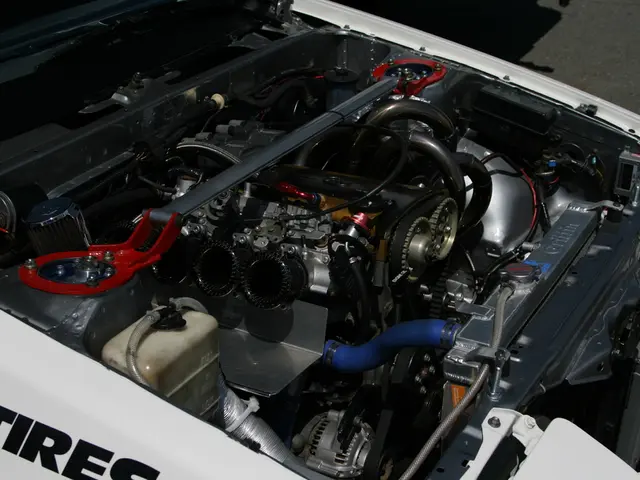Smackdown of Smartphone Batteries: Apple, Samsung, OnePlus, Xiaomi, and Google Unleashed
Assessing Battery Performance Across Top Smartphone Manufacturers
Battery technology in smartphones has skyrocketed, with industry giants like Apple, Samsung, OnePlus, Xiaomi, and Google furiously competing to deliver the best battery performance. Let's drill down into their strategies for battery capacity, charging speeds, and power-saving technologies to determine which one reigns supreme.
Apple: Flawless Integration and Performance Optimization
Apple's iPhones are celebrated for their harmonious blend of hardware and software. Despite smaller battery capacities compared to some Android contenders (usually between 3000mAh to 3500mAh for recent models), Apple concentrates heavily on software optimization to squeeze the most out of their batteries.
Perks of Apple Batteries:
- Flaunt Your Software: iOS operates efficiently alongside the hardware, granting long battery life even with smaller battery capacities.
- Peek Under the Hood: The iPhone packs a built-in "Battery Health" feature that allows users to check the battery's condition and receive a heads-up when it's time to replace.
- Thrifty Power Management: Apple's "Low Power Mode" and "Optimized Battery Charging" tools stretch the battery life by reducing nonessential processes and learning the user's charging habits.
Pitfalls of Apple Batteries:
- Tiny Capacity: iPhone batteries have smaller capacity compared to many Android devices, which might mean shorter battery life during heavy usage.
- Costly Battery Replacements: Apple's official battery replacements can be pricy compared to third-party options, and some users have complained about limited repair options.
Samsung: Brawn and Speed
Samsung has long dominated battery technology, providing sizeable battery capacities in its flagship Galaxy S and Note series. Samsung also puts a strong emphasis on fast charging and boasts some of the fastest charging speeds on the market.
Pros of Samsung Batteries:
- Brawny Batteries: Samsung Galaxy S and Note series commonly come with large batteries, ranging from 4000mAh to 5000mAh, yielding extended usage times—especially for power users and intensive smartphone tasks.
- Lightning-Fast Charging: Samsung supports exceptionally fast charging speeds, with some devices offering 45W fast charging, enabling users to quickly replenish their energy stores in a jiffy.
- Smart Battery Optimization: Samsung phones offer "Adaptive Battery" technology, which employs AI to learn how you use your phone and minimizes battery usage for apps you seldom use.
Cons of Samsung Batteries:
- Sagging Performance Over Time: Like most lithium-ion batteries, Samsung's batteries degrade over time, and some users report that battery life weakens faster compared to other brands.
- Bloatware: Samsung's Android skin, One UI, can sometimes be power-greedy due to extra features and customizations, which may consume more battery.
OnePlus: Speed and Efficiency
OnePlus has carved out a niche for itself by offering high-performance smartphones with generous batteries and lightning-fast charging speeds. OnePlus emphasizes delivering a smooth user experience, which encompasses an optimal battery system as well.
Pros of OnePlus Batteries:
- Bolt from the Blue: OnePlus is well-known for its "Warp Charge" technology, offering swift charging speeds, enabling users to charge from 0% to 50% in mere 15 minutes.
- Ample Battery Capacity: OnePlus devices come decked out with batteries ranging from 4000mAh to 5000mAh, ensuring users have sufficient power to get through a complete day of usage.
- Clean and Efficient OxygenOS: OnePlus' OxygenOS is light on bloatware, providing a streamlined and efficient Android experience that boosts battery performance.
Negatives of OnePlus Batteries:
- Battery Endurance: Although OnePlus batteries are generally efficient, they aren't always optimized as well as those from Apple or Samsung, which may impact long-term performance.
- Raging Heat: OnePlus' fast charging can generate considerable heat, which might affect the long-term health of the battery if used frequently.
Xiaomi: Monster Capacities and Budget-Friendly Options
Xiaomi, known for its pocket-friendly smartphones, has made great strides in battery technology. The brand offers gigantic batteries in many of its devices and integrates speedy charging and power-saving features to enhance the user experience.
Pros of Xiaomi Batteries:
- Mammoth Battery Reserves: Xiaomi's smartphones, like the Redmi and Mi series, typically feature batteries exceeding 4000mAh, making them larger than most other devices on the market, ensuring longer battery life.
- Charging Thunderbolts: Xiaomi has adopted fast charging technology, with some of its flagships offering up to 67W fast charging, allowing users to recharge in no time.
- MIUI Battery Management: Xiaomi's MIUI software comes equipped with several battery-saving features, like limiting background apps and offering an adaptive power-saving mode.
Negatives of Xiaomi Batteries:
- Software Bloating: Xiaomi's MIUI is renowned for its extensive customization and features, which can sometimes drain more power compared to lighter Android skins.
- Gradual Battery Degradation: As with most smartphones, Xiaomi's batteries degrade over time, and some users report faster battery deterioration in low-cost devices.
Google: AI-Powered Power Management
Google's Pixel smartphones might not break records with their battery capacity, but the company has invested significantly in AI-powered power management to maximize battery efficiency. Google's approach emphasizes smart software optimizations over sheer battery size.
Perks of Google Batteries:
- Cunning Artificial Intelligence: Google's Pixel devices employ AI and machine learning to optimize battery usage based on the user's habits, ensuring that battery life lasts long even when capacities are relatively modest (typically ranging between 3000mAh to 4000mAh).
- Adaptive Battery Genius: Google's "Adaptive Battery" technology prioritizes apps that are frequently used while minimizing power usage for apps that aren't used often, extending battery life.
- Electric Juice Sharing: Pixel devices feature wireless reverse charging, which enables users to charge other devices, like earbuds or another phone, using their Pixel device's battery.
Cons of Google Batteries:
- Slightly Small Battery Capacities: Compared to other brands like Samsung and Xiaomi, Pixel phones often have smaller battery capacities, which may result in shorter battery life for heavy users.
- Battery Resilience: Some users report that Pixel batteries don't hold up well over time compared to competitors like Samsung or OnePlus, which might necessitate more frequent charging as the device grows older.
Key Differences Between Smartphone Batteries
Capacity and Longevity
- Apple typically opts for smaller batteries but focuses heavily on software optimizations to extend battery life.
- Samsung leads in battery capacity, furnishing hefty batteries in its flagships, ensuring long-lasting power.
- OnePlus offers the perfect balance of sizeable batteries and fast charging, catering to those who need revitalization in a hurry.
- Xiaomi provides large batteries in its devices, with certain models reaching 6000mAh, making a fantastic choice for users who prioritize battery longevity.
- Google prioritizes efficient software management for optimized battery life through AI and machine learning.
Charging Speed
- Apple supports decent fast charging up to 20W, although new models may boast faster speeds.
- Samsung unleashes fast charging up to 45W on select models, like the Galaxy S family.
- OnePlus is renowned for its incredible charging speeds, offering 65W charging on some devices.
- Xiaomi also supports speedy charging up to 120W on some models.
- Google generally offers decent fast charging but primarily focuses on power management rather than breaking charging speed records.
Software Optimizations
- Apple delivers highly efficient software powered by seamless hardware integration.
- Samsung offers features like Power-saving mode and optimization for battery life via software updates.
- OnePlus provides a smooth user experience with efficient software, including Power-saving mode and battery longevity enhancements.
- Xiaomi features similar optimizations with Power-saving mode and battery management options.
- Google offers an Android experience on Pixel devices equipped with features like Adaptive Battery and adaptive power-saving modes.
Round-Up: Which King of the Batteries Rules?
When comparing batteries from Apple, Samsung, OnePlus, Xiaomi, and Google, there's no one-size-fits-all response. The ideal smartphone battery depends on your preferences and usage habits:
- Apple excels in software optimizations and overall battery health, making it a superb choice for users prioritizing steadfast longevity over sheer battery size.
- Samsung boasts larger batteries and the fastest charging speeds, making it perfect for heavy power users and intensive smartphone activities.
- OnePlus offers an appealing balance of battery capacity, sizeable batteries, and speedy charging—ideal for users needing quick charges.
- Xiaomi offers devices with massive batteries, perfect for frugal users wanting long battery life at rock-bottom prices.
- Google concentrates on efficient software management, making its devices an excellent option for users looking to prioritize battery longevity through AI-powered optimizations.
Each brand brings its unique blend of strengths to the mix; it's essential to concentrate on what matters most to you in a smartphone battery.
Apple's batteries prioritize software optimizations and efficiency, offering long battery life despite smaller capacities. Samsung, on the other hand, focuses on large battery capacities and fast charging, delivering extended usage times for intensive tasks. OnePlus effectively balances sizeable batteries, fast charging, and a smooth user experience, catering to those who need quick charges. Xiaomi provides devices with gigantic batteries, offering extended battery life at budget-friendly price points. Google emphasizes AI-powered power management to optimize battery life, providing efficient performance with relatively modest battery capacities.




